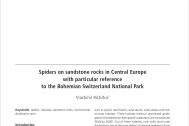Rok
2007Autoři
RNDr. Vlastimil Růžička, CSc.Druhy
Histopona torpida (C. L. Koch, 1837) ESAmaurobius fenestralis (Ström, 1768) ES
Callobius claustrarius (Hahn, 1833) ES
Cicurina cicur (Fabricius, 1793) ES
Harpactea lepida (C. L. Koch, 1838) ES
Drassodes lapidosus (Walckenaer, 1802) ES
Zelotes petrensis (C. L. Koch, 1839) ES
Zelotes puritanus Chamberlin, 1922 EN
Hahnia pusilla C. L. Koch, 1841 ES
Xerolycosa nemoralis (Westring, 1861) ES
Nesticus cellulanus (Clerck, 1757) ES
Aelurillus v-insignitus (Clerck, 1757) ES
Episinus truncatus Latreille, 1809 LC
Zodarion germanicum (C. L. Koch, 1837) ES
Obsah
While the majority of the Central European landscape would be covered by forests without human influence, rocky areas form isolated, islet-like, natural, non-forest habitats. The surface of some of these non-forested areas is composed of bare bedrock or products of its erosional breakdown (without a soil layer) such as gravel, sand banks, sand dunes, scree slopes and rock outcrop habitats. These habitats harbour specialized spider species that depend on their specific substratum and microclimate (Růžička 2000). Out of these habitats, rock walls (and scree slopes) form one of the most distinct ecological gradients of any terrestrial ecosystem (Larson et al. 1989, Růžička et al. 1995). They provide habitats with extremely warm and cold microclimatic conditions in close proximity. They also belong to habitats almost unknown until now due to the technical and practical problems of sampling.
Sandstones can form extensive systems of rocks, sometimes with a broad spectrum of meso- and microhabitats due to their very dynamic relief. Sandstone rocks are characterised by a marked contrast between forested plateau and bare vertical rock walls (Balatka and Sládek 1984). Upper margins of rocks are dry, vertical rock walls can be sun-exposed, dry and bare, or shady and humid and hence covered by mosses. Spaces with an extremely cold climate can occur in deep gorges. The aim of this study is to evaluate available data on the species composition of spider assemblages in sandstone rocks, including new data about spiders on rock walls in the Bohemian Switzerland (České Švýcarsko) National Park.



